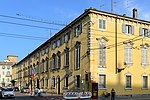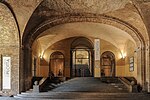Ducal Palace of Parma
Baroque palaces in ItalyBuildings and structures in ParmaDemolished buildings and structures in ItalyDuchy of ParmaFarnese residences ... and 4 more
Former palacesHouse of FarneseNeoclassical palaces in ItalyPalaces in Parma

The Ducal Palace of Parma (Italian: Palazzo Ducale di Parma) was a neoclassical palace in Parma, Italy. It was located on the west side of the located at the Piazzale della Pace. Between its construction and 1866, it was the residence of the Dukes of Parma. Afterwards, it became the prefecture. During the Second World War, the palace was destroyed during air raids in 1944, and it was afterwards not reconstructed.
Excerpt from the Wikipedia article Ducal Palace of Parma (License: CC BY-SA 3.0, Authors, Images).Ducal Palace of Parma
Piazza della Pace, Parma Parma Centro
Geographical coordinates (GPS) Address Nearby Places Show on map
Geographical coordinates (GPS)
| Latitude | Longitude |
|---|---|
| N 44.804129 ° | E 10.327056 ° |
Address
Piazza della Pace
Piazza della Pace
Parma, Parma Centro
Emilia-Romagna, Italy
Open on Google Maps











